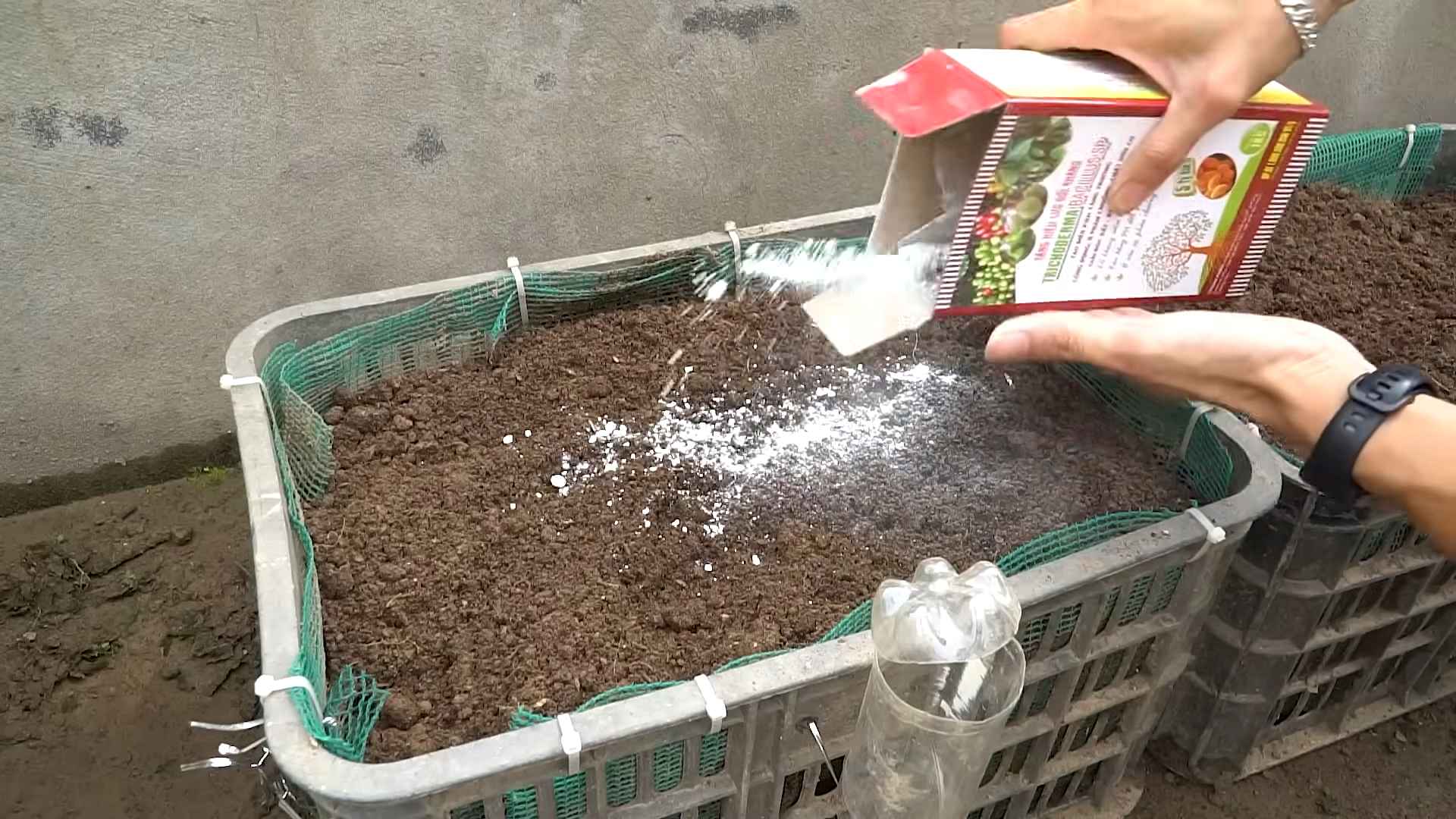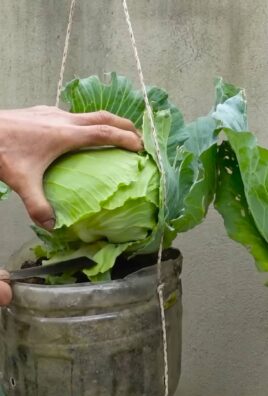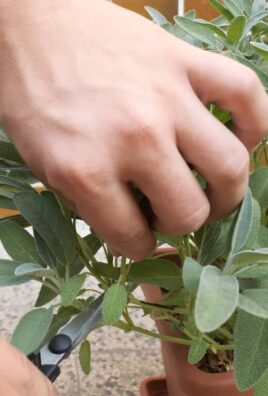Grow Eggplants at Home Easily? Absolutely! Imagine strolling into your backyard and harvesting plump, glossy eggplants, ready to be transformed into a delicious ratatouille or a smoky baba ghanoush. Sounds dreamy, right? Well, it doesn’t have to be just a dream! For centuries, cultivating your own food has been a source of pride and sustenance, connecting us to the earth and providing fresh, healthy ingredients. From ancient civilizations tending their gardens to modern-day urban farmers, the desire to nurture and harvest has remained a constant.
But let’s be honest, the thought of growing eggplants can seem a little intimidating. Maybe you’ve tried before with less-than-stellar results, or perhaps you’re a complete beginner. That’s where these simple, yet effective, DIY tricks and hacks come in! I’m here to show you that you don’t need a sprawling farm or a green thumb of legend to grow eggplants at home easily. With a few clever techniques and a little bit of know-how, you can enjoy a bountiful eggplant harvest, right from your own backyard (or even your balcony!).
Why do you need these DIY tricks? Because store-bought eggplants often lack the vibrant flavor and freshness of homegrown ones. Plus, growing your own allows you to control exactly what goes into your food, avoiding harmful pesticides and ensuring the highest quality produce. So, let’s ditch the grocery store and get our hands dirty! Get ready to unlock the secrets to successful eggplant gardening and enjoy the satisfaction of harvesting your very own delicious, homegrown eggplants.

Growing Eggplants at Home: A Beginner’s Guide
Hey there, fellow gardening enthusiasts! I’m so excited to share my experience and guide you through growing your own delicious eggplants right at home. It’s easier than you might think, and the satisfaction of harvesting your own produce is truly rewarding. Let’s get started!
Choosing Your Eggplant Variety
Before we dive into the nitty-gritty, let’s talk about eggplant varieties. There’s a whole world beyond the classic large, purple globe eggplant you see in most grocery stores. Consider these factors when choosing:
* Climate: Some varieties are better suited for warmer climates, while others can tolerate cooler temperatures. Check your local growing zone and choose accordingly.
* Space: If you’re growing in containers, opt for compact varieties like ‘Patio Baby’ or ‘Fairy Tale’.
* Taste Preference: Do you prefer a mild, creamy eggplant or one with a slightly bitter flavor? Research different varieties to find one that suits your palate. Some popular choices include:
* Black Beauty: The classic, large purple eggplant.
* Japanese Eggplant (Ichiban): Long, slender, and mild-flavored.
* Italian Eggplant (Rosa Bianca): Round, lavender-pink, and sweet.
* Thai Eggplant: Small, round, and often green or white.
Starting Your Eggplant Seeds (or Buying Seedlings)
You have two options here: starting your own seeds indoors or buying seedlings from a local nursery. Starting from seed gives you more control over the variety and can be more cost-effective, but it requires a bit more time and effort.
Starting Seeds Indoors (Recommended for Most Climates)
Eggplants need a long growing season, so starting seeds indoors 6-8 weeks before the last expected frost is crucial.
1. Gather Your Supplies:
* Seed starting tray with drainage holes
* Seed starting mix (a sterile, lightweight mix)
* Eggplant seeds
* Spray bottle
* Heat mat (optional, but helpful)
* Grow light (optional, but recommended)
2. Sow the Seeds:
* Moisten the seed starting mix thoroughly.
* Fill the seed starting tray with the moistened mix.
* Make a small indentation (about ¼ inch deep) in each cell.
* Place 2-3 seeds in each indentation.
* Gently cover the seeds with the seed starting mix.
* Lightly mist the surface with water.
3. Provide Warmth and Light:
* Place the seed starting tray on a heat mat (if using) to maintain a soil temperature of 80-90°F (27-32°C).
* Cover the tray with a humidity dome or plastic wrap to retain moisture.
* Place the tray under a grow light or in a sunny window. If using a grow light, keep it a few inches above the tray and adjust as the seedlings grow.
4. Maintain Moisture:
* Keep the seed starting mix consistently moist, but not soggy. Mist the surface with water as needed.
* Once the seedlings emerge, remove the humidity dome or plastic wrap.
5. Thin the Seedlings:
* Once the seedlings have their first true leaves (the second set of leaves), thin them to one seedling per cell. Choose the strongest, healthiest seedling and snip off the others at the soil line.
6. Harden Off the Seedlings:
* About a week before you plan to transplant the seedlings outdoors, begin hardening them off. This process gradually acclimates them to outdoor conditions.
* Start by placing the seedlings outdoors in a sheltered location for an hour or two each day, gradually increasing the amount of time they spend outdoors.
* Protect them from direct sunlight and strong winds.
Buying Seedlings
If you prefer to skip the seed starting process, you can purchase seedlings from a local nursery. Choose healthy-looking seedlings with sturdy stems and no signs of disease or pests.
Preparing Your Garden Bed or Containers
Eggplants need well-drained soil that is rich in organic matter. They also need plenty of sunlight – at least 6-8 hours per day.
Preparing the Garden Bed
1. Choose a Sunny Location: Select a spot in your garden that receives at least 6-8 hours of direct sunlight per day.
2. Amend the Soil: Eggplants thrive in well-drained soil that is rich in organic matter. Amend the soil with compost, aged manure, or other organic materials.
3. Check the Soil pH: Eggplants prefer a soil pH of 6.0-7.0. You can test your soil pH with a soil testing kit and amend it accordingly.
4. Prepare the Planting Holes: Dig holes that are slightly larger than the root balls of your seedlings. Space the holes 24-36 inches apart, depending on the variety.
Preparing Containers
1. Choose the Right Size Container: Eggplants need a large container to accommodate their root systems. A 5-gallon container is the minimum size, but a 10-gallon container is even better.
2. Use a High-Quality Potting Mix: Use a well-draining potting mix that is specifically formulated for containers.
3. Ensure Drainage: Make sure the container has drainage holes to prevent waterlogging.
Transplanting Your Eggplant Seedlings
Once the danger of frost has passed and the soil has warmed up, it’s time to transplant your eggplant seedlings into the garden or containers.
1. Water the Seedlings: Water the seedlings thoroughly before transplanting.
2. Carefully Remove the Seedlings: Gently remove the seedlings from their cells, being careful not to damage the roots.
3. Plant the Seedlings: Place the seedlings in the prepared holes, making sure the top of the root ball is level with the soil surface.
4. Backfill with Soil: Fill the holes with soil and gently firm the soil around the seedlings.
5. Water Thoroughly: Water the seedlings thoroughly after transplanting.
6. Mulch: Apply a layer of mulch around the plants to help retain moisture, suppress weeds, and regulate soil temperature. I like using straw or shredded leaves.
Caring for Your Eggplant Plants
Now that your eggplants are planted, it’s important to provide them with the care they need to thrive.
* Watering: Water your eggplant plants regularly, especially during hot, dry weather. Aim to keep the soil consistently moist, but not soggy. Water deeply and less frequently, rather than shallowly and often.
* Fertilizing: Eggplants are heavy feeders, so they need regular fertilization. Use a balanced fertilizer or a fertilizer specifically formulated for vegetables. Follow the instructions on the fertilizer label. I usually fertilize every 2-3 weeks.
* Staking: As your eggplant plants grow, they may need to be staked to support the weight of the fruit. Use stakes or cages to keep the plants upright and prevent the branches from breaking.
* Pruning: Pruning can help improve air circulation and sunlight penetration, which can lead to healthier plants and larger fruit. Remove any suckers (small shoots that grow from the base of the plant) and any yellowing or diseased leaves.
* Pest and Disease Control: Eggplants are susceptible to a variety of pests and diseases, including aphids, flea beetles, and blossom-end rot. Inspect your plants regularly for signs of pests or diseases and take action promptly. I prefer using organic pest control methods whenever possible. Neem oil is a great option for many common pests.
Harvesting Your Eggplants
The moment you’ve been waiting for! Eggplants are typically ready to harvest 65-80 days after transplanting, depending on the variety.
* Check for Ripeness: The skin of the eggplant should be glossy and firm. Gently press the skin with your finger; if it leaves an indentation, the eggplant is ripe.
* Harvest Carefully: Use a sharp knife or pruning shears to cut the eggplant from the plant, leaving about an inch of stem attached.
* Harvest Regularly: Harvest eggplants regularly to encourage the plant to produce more fruit.
Troubleshooting Common Problems
Even with the best care, you may encounter some problems while growing eggplants. Here are a few common issues and how to address them:
* Blossom-End Rot: This is a common problem caused by calcium deficiency. The bottom of the eggplant will develop a dark, sunken spot. To prevent blossom-end rot, ensure your soil has adequate calcium and water your plants consistently. You can also add calcium to the soil by using bone meal or crushed eggshells.
* Aphids: These small, sap-sucking insects can weaken your plants. Spray them with a

Conclusion
So, there you have it! Growing eggplants at home easily is not just a possibility; it’s a rewarding reality within your reach. We’ve demystified the process, broken down the steps, and armed you with the knowledge to cultivate your own thriving eggplant patch. Forget relying solely on grocery store produce – imagine the satisfaction of harvesting plump, glossy eggplants from your own backyard, knowing exactly where they came from and how they were grown.
This DIY trick isn’t just about saving money (though that’s certainly a perk!). It’s about connecting with nature, understanding the lifecycle of your food, and enjoying the unparalleled flavor of freshly picked vegetables. The taste difference between a store-bought eggplant and one you’ve nurtured yourself is truly remarkable. The homegrown variety boasts a richer, more complex flavor profile, free from the subtle bitterness that can sometimes plague commercially grown produce.
But the benefits extend beyond taste. By growing your own eggplants, you’re also contributing to a more sustainable lifestyle. You’re reducing your carbon footprint by eliminating transportation costs and supporting local, organic practices. Plus, gardening is a fantastic stress reliever! The simple act of tending to your plants, watching them grow, and nurturing them to fruition can be incredibly therapeutic.
Don’t be afraid to experiment! Once you’ve mastered the basics, consider exploring different eggplant varieties. From the classic Black Beauty to the slender Japanese eggplant or the vibrant Thai green eggplant, there’s a whole world of flavors and textures to discover. You can also try companion planting, pairing your eggplants with herbs like basil or thyme to deter pests and enhance their flavor. Another variation is to experiment with different growing mediums. While we’ve focused on traditional soil-based gardening, you could also explore container gardening or even hydroponics for a more controlled environment.
Growing eggplants at home easily is an adventure, and we encourage you to embark on it! Don’t be discouraged by initial setbacks – gardening is a learning process, and every season brings new opportunities to refine your techniques. The key is to be patient, observant, and willing to adapt to the unique conditions of your garden.
We’re confident that with a little effort and dedication, you’ll be enjoying a bountiful harvest of delicious, homegrown eggplants in no time. So, grab your gardening gloves, gather your supplies, and get ready to experience the joy of growing your own food.
And most importantly, we want to hear about your experiences! Share your successes, your challenges, and your tips with us in the comments below. Let’s create a community of eggplant enthusiasts, sharing our knowledge and inspiring each other to grow the best eggplants possible. Happy gardening!
Frequently Asked Questions (FAQ)
What is the best time of year to start growing eggplants?
Eggplants are warm-weather crops, so they need plenty of sunshine and warm temperatures to thrive. The best time to start growing eggplants is in the late spring or early summer, after the last frost has passed. If you live in a region with a short growing season, you can start your seeds indoors 6-8 weeks before the last frost and then transplant them outdoors once the weather warms up. Make sure the soil temperature is consistently above 60°F (15°C) before transplanting.
How much sunlight do eggplants need?
Eggplants require at least 6-8 hours of direct sunlight per day to produce a good yield. Choose a sunny location in your garden where your eggplants will receive ample sunlight throughout the day. If you’re growing eggplants in containers, make sure to place them in a sunny spot on your patio or balcony. Insufficient sunlight can lead to leggy plants and reduced fruit production.
What kind of soil is best for growing eggplants?
Eggplants prefer well-drained, fertile soil that is rich in organic matter. The ideal soil pH for eggplants is between 6.0 and 6.8. Before planting, amend your soil with compost or well-rotted manure to improve its fertility and drainage. You can also add a slow-release fertilizer to provide your eggplants with the nutrients they need throughout the growing season. Avoid heavy clay soils, as they can become waterlogged and inhibit root growth.
How often should I water my eggplants?
Eggplants need consistent moisture to thrive, especially during hot, dry weather. Water your eggplants deeply and regularly, aiming to keep the soil consistently moist but not waterlogged. Water at the base of the plants to avoid wetting the foliage, which can increase the risk of fungal diseases. Mulching around your eggplants can help to retain moisture in the soil and suppress weed growth. Check the soil moisture regularly and adjust your watering schedule as needed.
What are some common pests and diseases that affect eggplants?
Eggplants are susceptible to a variety of pests and diseases, including aphids, flea beetles, spider mites, and verticillium wilt. Regularly inspect your plants for signs of infestation or disease. You can control aphids and spider mites with insecticidal soap or neem oil. Flea beetles can be managed with row covers or by applying diatomaceous earth around the plants. To prevent verticillium wilt, choose disease-resistant eggplant varieties and practice crop rotation. Good air circulation and proper watering can also help to prevent fungal diseases.
How do I know when my eggplants are ready to harvest?
Eggplants are typically ready to harvest when they are firm, glossy, and have reached their mature size. The skin should be smooth and unblemished. Gently press the eggplant with your thumb – if it gives slightly, it’s ripe. Overripe eggplants will become dull, soft, and bitter. Use a sharp knife or pruning shears to cut the eggplant from the plant, leaving a short stem attached. Harvest your eggplants regularly to encourage continued fruit production.
Can I grow eggplants in containers?
Yes, eggplants can be successfully grown in containers, especially if you have limited garden space. Choose a large container that is at least 12 inches in diameter and 12 inches deep. Use a high-quality potting mix that is well-draining and rich in organic matter. Make sure the container has drainage holes to prevent waterlogging. Place the container in a sunny location and water regularly. You may need to fertilize your container-grown eggplants more frequently than those grown in the ground.
How can I encourage more fruit production on my eggplant plants?
To encourage more fruit production on your eggplant plants, make sure they are receiving adequate sunlight, water, and nutrients. Prune your plants to remove suckers (small shoots that grow from the base of the plant) and any yellowing or diseased leaves. You can also pinch off the tips of the branches to encourage branching and more fruit production. Consider using a blossom-set spray to improve fruit set, especially during hot weather.
What are some good companion plants for eggplants?
Companion planting can help to deter pests, attract beneficial insects, and improve the overall health of your eggplant plants. Good companion plants for eggplants include basil, thyme, marigolds, and peppers. Basil helps to repel aphids and whiteflies, while thyme deters cabbage moths. Marigolds attract beneficial insects like ladybugs and hoverflies, which prey on aphids. Peppers can provide shade for eggplants during hot weather. Avoid planting eggplants near fennel, as it can inhibit their growth.
How do I store harvested eggplants?
Harvested eggplants should be stored in a cool, dry place, such as the refrigerator. Wrap them loosely in plastic wrap or place them in a perforated plastic bag to prevent them from drying out. Eggplants can be stored in the refrigerator for up to a week. Avoid storing them near ethylene-producing fruits like apples and bananas, as this can cause them to ripen too quickly.




Leave a Comment